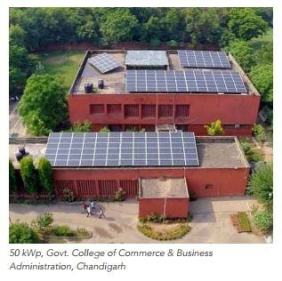Yes. Saves energy, saves money and is an environmentally cleaner option.
With an average solar insolation of 4-7 kWh/m and 300 sunny days in a year, India’s potential for harnessing solar power is immense. Government of India wants a growing share of the country’s electricity generation to come from renewable energy. India plans to install 40 GW of PV Rooftop Solar Systems (grid connected) by 2022. With a market potential of 124 GW, around 506 MW of Rooftop Solar has been installed up to December 2016.
To achieve this target, Ministry of New and Renewable Energy is providing a CFA (Central Finance Assistance) or subsidy for Solar Rooftop PV implementations. The CFA is 30% of the benchmark cost for general category states/UTs and 70% of the benchmark cost for North Eastern states, islands and J&K. This subsidy is available for domestic users. For commercial and industrial users, the depreciation (for taxation purposes) calculated per year on investment towards solar PV systems is as high as 40%. State Energy Development Agencies are also offering additional subsidies over and above the one offered by MNRE. For example, Gujarat Energy Development Agency (GEDA) is offering a Rs. 10,000 subsidy on 1 kW systems and Rs. 20,000 subsidy on 2 kW and above systems. Hence, once maths is put in, the investment return (gestation) period is mere 4 years in case of both residential as well as commercial projects.
The cost for setting up a residential rooftop solar PV system with Indian manufactured panels comes between Rs.55-65/watt (turnkey/EPC) without subsidies. With subsidies, the cost is as low as Rs.39/watt. For large scale commercial projects the costs are, obviously, further low.
But in place of opting for standalone rooftop solar systems (off grid), it better to go for ‘grid-connected’ solar systems where your solar system is connected to your electricity supply (or your electricity distribution company / DISCOM).
The main difference between the two is storage. In an Off-Grid system, you need batteries to store electricity. But in a Grid-Connected system, you do not need batteries as whatever electricity is produced through the system, it can be sold to your electricity distribution company (or electricity-supply company). Batteries are a big cost component in the Off-Grid system which makes the latter expensive. And not just expensive, but inefficient as well because batteries inherently lose electricity/energy.
The procedure to sell (and procure) electricity is termed as ‘net metering’ which is achieved by installing a single bi-directional meter along with the system. When you consume electricity from the grid (or your electricity supply), the meter readings will move forward; but, when you produce electricity and send it to the grid, the meter readings shall move backward. Suppose you use 10 units of electricity in a day and produce 8 units, your meter will show a reading of 2 units. And if you use 10 units of electricity and produce 12 units, then your meter will show -2 units. Your bill at the end of the month will be based on net units consumed/produced. If you generate extra electricity in any month, the surplus is carried over to the next month and netted. At the end of a year, if your total production is more than what you consumed, then you will get paid for the next surplus electricity produced at the cost decided by your state’s electricity regulatory commission. Cool?

And over and above all this, your vacant roof space gets utilized. Designers are getting together with engineers to make panels mount in an aesthetically pleasing way.
In Short: You save money, save the world, make your home look beautiful, contribute to saving the environment. Perfect time to go solar in a solar rich nation.
References:
- National Solar Mission Grid Connected Solar Rooftop Programme in India
- How to get “Grid Connected” Solar PV Rooftop System in India – A Step by Step Procedure – Bijli Bachao
- Grid-Tied, Off-Grid and Hybrid Solar Systems – Energy Informative
- India’s rooftop solar sector – A success story but challenges remain – Opinion by Amit Kumar | ET EnergyWorld